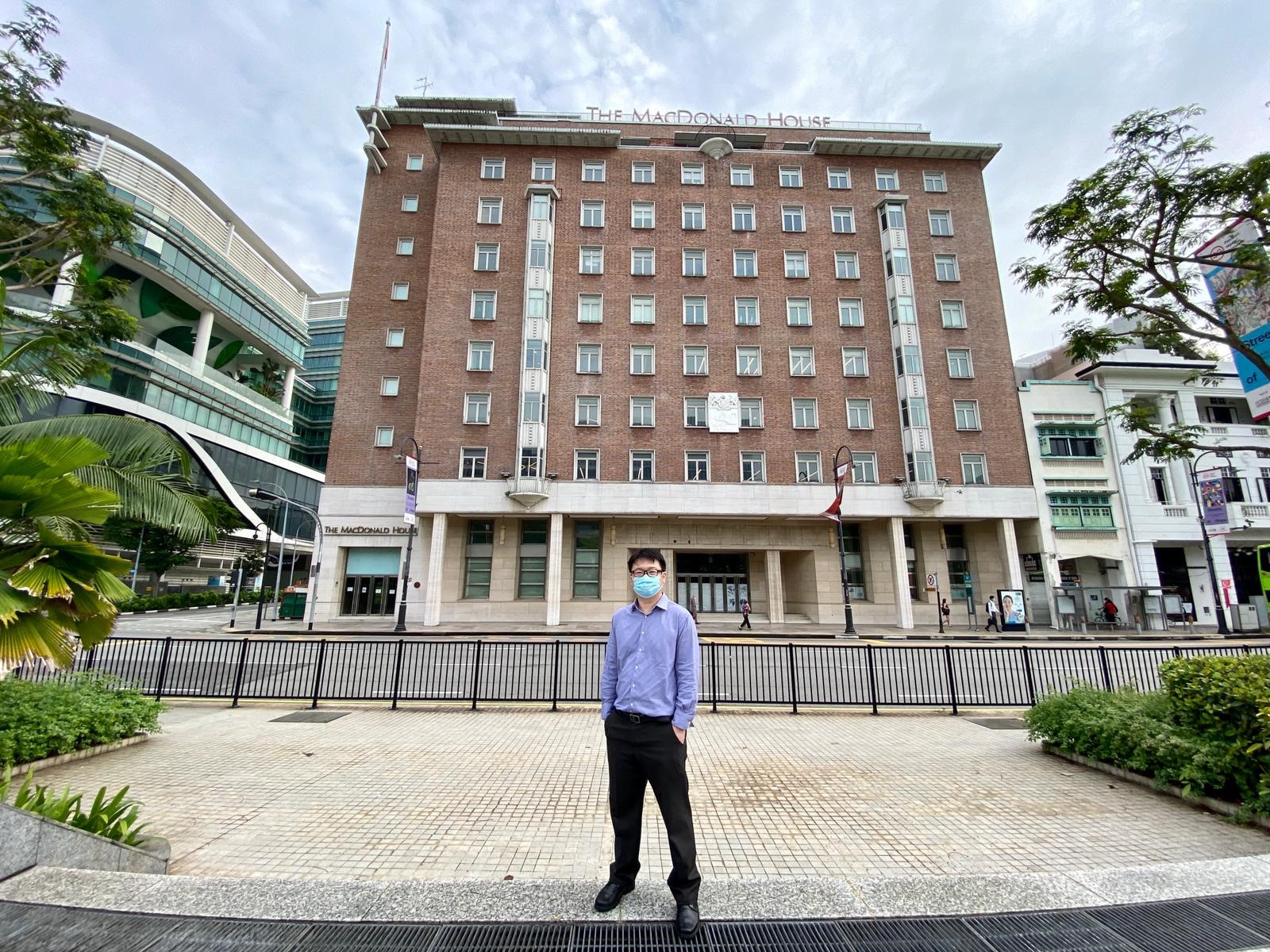No building in Singapore has suffered a bomb attack since terrorists planted bombs in the McDonald House in 1965, which killed three people.
But it is not something that should be taken for granted.
Which is why engineers like Er. Dr. Tan Swee Hong, who heads the Blast Engineering Branch of HTX's Protective Security & Safety Centre of Expertise, specialise in designing “mitigation measures” to protect buildings, and the people inside, from the effects of bombs and explosives. For instance, encasing columns with steel jackets to improve the resilience so the building can continue standing and is less likely to collapse.
 Er. Dr. Tan Swee Hong in front of MacDonald House (Photo: HTX)
Er. Dr. Tan Swee Hong in front of MacDonald House (Photo: HTX)
Trained in civil and structural engineering, and now a registered Professional Engineer, he meandered into blast engineering when a friend told him about 15 years ago that the Defence Science and Technology Agency (DSTA) was recruiting for protection of civilian buildings and encouraged him to try for it.
That was in the wake of the devastating 9/11 blasts in America.
“At the time, I was working as a site engineer with a contractor. I recalled meeting my ex-classmate at a coffeeshop in Bras Basah Complex. After talking to him, something in my mind ticked and I decided to go into public service!” said Swee Hong.
He joined DSTA for four years before going to the Ministry of Home Affairs where he further honed his blast engineering expertise.
There are few blast engineers in Singapore, who focus on protection of civilian buildings.
Swee Hong acknowledges that the work of blast engineers is often “invisible”. Protection of buildings take place in the background – by deterring would-be attackers, and in preventing mass casualties and mitigating damages, when an attack does occur. Notwithstanding the lack of visibility and recognition, “you really do not want your design to be tested”, he said.
 (Photo: HTX)
(Photo: HTX)
But the need for their expertise became more pronounced in December 2018, when Singapore’s Infrastructure Protection Act came into effect. There are legal requirements – including blast engineering measures – when it comes to building security, and is part of Singapore’s national counter-terrorism framework.
At HTX now, he is responsible for conducting research about blast engineering, developing industry guidelines, and nurturing a group of public sector engineers who would have the knowledge to regulate the private sector – by reviewing the design and assessment submitted by companies, to ensure that they meet the desired security outcomes.
 (Photo: HTX)
(Photo: HTX)
“It is not easy. The key underlying principles and mathematics of blast engineering are not widely taught in universities and many mid-career engineers are averse to learning new engineering concepts from first principles,” he said. “But it is important that HTX, as the leading agency in protective security, maintains a high level of technical competency to stay at the very forefront.”
What Swee Hong is doing is critical because blast engineering is not something that is taught in schools as a dedicated course. It is a niche specialisation with few practitioners in Singapore.
He said, “This is understandable as the immediate demand for tertiary institutions is to train engineers for common conventional buildings."
Blast engineering is usually learnt on the job, taught by an experienced engineer like Swee Hong, and as part of continual learning if the engineer is passionate about the subject.
It is not easy. The key underlying principles and mathematics of blast engineering are not widely taught in universities and many mid-career engineers are averse to learning new engineering concepts from first principles. But it is important that HTX, as the leading agency in protective security, maintains a high level of technical competency to stay at the very forefront.
“As such, a structured and incremental approach towards capability development is necessary,” he said.
He is also applying his knowledge to new forms of construction. These days, in order to reduce reliance on foreign labour and to be more productive, more are not built from scratch.
Rather, pre-fabricated structures are made elsewhere and brought to site to be pieced together, like Lego pieces.
“Although “Lego-style structures” can be built relatively fast, they do not typically possess the structural robustness against extreme conditions such as blast effects,” said Swee Hong, who is working on research-based guidelines, in collaboration with the universities, which would be published and shared with the rest of the industry.
He added, “I enjoy my work because blast engineering is an emerging science with many areas waiting to be uncovered. I also enjoy building up ties with universities to leverage on their expertise, and nurturing more blast engineers.”
We are always seeking inquisitive and innovative individuals to co-create extraordinary solutions with us.
Join us to be at the forefront of the finest tech capabilities in the field! Join Us

